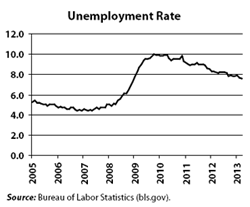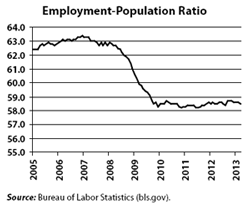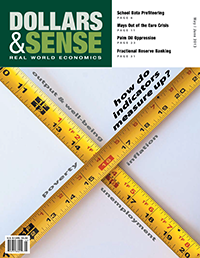The "headline" unemployment rate, or U-3 by its Bureau of Labor Statistics (BLS) designation, has declined from a peak of 10.0% in late 2009 to 7.5% now. The unemployment rate--the number of unemployed people as a percentage of the labor force (the employed plus unemployed)--is still abnormally high. Before the onset of the current crisis, it had been this high for only five months (May-September 1992) in the previous 24 years.

The jobs situation now is certainly drastically different from 2008-2010, when unemployment was increasing dramatically--there's no argument about that. At the bleakest point of the recession, in each of two consecutive months (January-February 2009), over half a million more people went from being employed to unemployed than from unemployed to employed. In March 2013, in contrast, over 250,000 more people went from being unemployed to employed than the reverse. But the end of the employment freefall is hardly the same thing as a robust recovery.


May/June 2013 issue.
The trend in the employment-to-population ratio--a much less familiar indicator than the headline unemployment rate--tells a different tale. This figure is the number of employed individuals as a percentage of the working-age civilian noninstitutional population. The civilian noninstitutional population excludes military personnel, people in prison, and so on. Working age, meanwhile, is defined as 16 years and over.
So there are two big differences between this measure and the unemployment rate. First, the numerator is employment rather than unemployment (so it's looking at the other side of the employment coin). Second, the denominator is not the size of the labor force (the employed plus the unemployed), but the civilian noninstitutional population (which also includes people who are not in the labor force, or NLF). Here, we see not an employment situation that has turned decisively toward recovery, but that has flatlined for more than three years.

Employed, Unemployed, or Neither
How can the unemployment rate have gone steadily down for about three years with hardly a budge to the employment-population ratio? Shouldn't the two move in opposite directions? (They did during the freefall of 2008-2010.) To get a handle on this, we have to look at the way the "headline" unemployment rate is calculated, starting with the official government definition of unemployment. For the BLS to count someone as unemployed, three things have to be true:
- That person cannot be employed. In this context, being employed means working at all, whether full-time or part-time, "for pay or profit." People who work for wages, work at a business they own, or work even without direct pay at their family business are counted as employed.
- That person must be actively looking for a job. That means doing things like filling out job applications, visiting an employment office, going to a job interview, etc.
- That person must be available to start work. This means that someone who is looking for a job, but would not accept a job that required them to start immediately (for example, a student who would not be ready to start until after graduation, some months in the future) is not unemployed for the purposes of calculating U-3.
People who are not employed (meet criterion #1) but are not actively looking for work or are not available to work (do not meet criterion #2 or #3) are classified as not in the labor force. In effect, then, we have defined three distinct groups: employed, unemployed, and not in the labor force. The employed and unemployed, together, constitute the labor force. The working-age population, meanwhile, is divided between those in the labor force and those not in the labor force.
How can we relate the unemployment rate, then, to the employment-to-population ratio? The employment-to-population ratio is equal to the employment rate (employment as a percentage of the labor force) times the labor-force participation rate (the labor force as a percentage of the population). The employment rate and the unemployment rate add up to one. So, if the unemployment rate is going down, the employment rate must be going up. If the employment rate is going up, but the employment-to-population rate is pretty much constant, the labor force participation rate must be going down. So we find the answer to our paradox--a declining unemployment rate with a flatlining employment-to-population ratio--in a plummeting labor force participation rate.
Between the mid 1960s and 1990, the U.S. labor force participation rate (LFPR) increased from just under 60% to about 66-67%, where it hovered until 2008. (The climb was driven by women's labor force participation, which increased fast enough to offset a mild decline in men's labor force participation.) Since the onset of the Great Recession, however, the overall labor force participation rate has dropped by about three percentage points. As economist Brad DeLong puts it, "There has been no closing of the output gap [the difference between actual and "full employment" output] and no decline in the unemployment rate from putting a greater share of the adult population to work. All of the decline in the output gap and of the decline in the unemployment rate is from the collapse in labor force participation."
OK, Then What?
Higher labor-force participation is not automatically better. People may choose to remain out of the labor force, or to leave the labor force, for reasons that are neither personally nor socially harmful. For example, someone may decide to stay in school (or to return to school after some period in the labor force) and not seek employment "for pay or profit." That decision might enhance their future work opportunities, increase their future labor productivity, and even contribute to the general level of knowledge in society. Increases in the labor force participation rate can reflect positive changes in society (e.g., increased work opportunities for women) or negative (e.g., cuts to retirement benefits). Decreases in the LFPR, by the same token, can happen for good reasons (e.g., increased educational opportunities) or bad (e.g., despair among the unemployed of ever finding a job).
So why has the labor-force participation rate fallen like a stone in the last few years? None of the standard ways to explain away the precipitous decline is convincing:
Skills mismatch. Neoclassical economists have emphasized a supposed mismatch between the skills workers have and those employers are seeking as an explanation of high unemployment since the Great Recession, but it works equally well (that is, equally badly) for people dropping out of the labor force altogether. This view has been roundly refuted by the lack of wage growth (as we would expect if appropriately skilled workers were in short supply), the high prevalence of involuntary part-time employment (these presumably do have the necessary skills yet their employers are not desperate to increase their hours), and other observations. (See John Millerand Jeannette Wicks-Lim, Skills Deficit or Jobs Deficit?, Dollars & Sense, January/February 2011.)
Demographic changes. As the U.S. population ages, we should expect a decline in the labor force participation rate. (Remember, the definition of the working-age population does not have a maximum age.) As DeLong points out, however, demographic changes account for a decline of less than 0.2 percentage points per year, and so would explain maybe 0.5 points of the decline in the LFPR over the last three years. "One-tenth of our labor-market shift relative to 2007 can be attributable to demography,' he concludes."[N]ine-tenths are the result of the Lesser Depression."
Cultural and political changes. A recent piece by the conservative New York Times columnist Ross Douthat, "A World Without Work" (Feb. 23, 2013), suggests that the decline in the LFPR reflects an increasing willingness by those at the bottom of the occupational hierarchy to just drop out of the working world altogether and scratch together a living from "disability payments and food stamps, living with relatives, cobbling together work here and there." This third explanation suffers from the same problem as the second--it's hard to imagine why there would have been such a precipitous change in the span of just a few years. It's not as if the U.S. welfare state has suddenly become more generous. Nor is there evidence of an abrupt cultural change in attitudes toward work.
The best explanation is that the decline is the fallout of a severe recession from which we have far from recovered. There simply are not enough jobs. After long spells of unemployment, many people give up on looking for work ("discouraged workers") and are reclassified as NLF. Others have entered the working-age population--turned 16 years old--or just graduated from high school or college and found few work opportunities. Some older workers retire, leaving the labor force, before they otherwise would have. The declining LFPR, however, is not restricted to younger or older workers. As Heidi Schierholz of the Economic Policy Institute puts it, "[T]he labor force participation rate of the 'prime-age' population, people age 25-54, is also at its lowest point of the downturn ... . It's the lack of job opportunities--the lack of demand for workers--that is keeping these workers from working or seeking work, not other factors."
The decline in the unemployment rate over the last few years has contributed to the complacent view that the worst is over, that most people who made it through without losing their jobs are pretty safe now (at least for the short term), and that no major policy intervention (like further fiscal stimulus) is required to improve the employment situation. It's clear from the employment-to-population and labor-force-participation data how wrong this view is, how inadequate the federal-level fiscal stimulus was, how premature its abandonment was, and how damaging the ongoing state-level austerity has been.
It's clear, in other words, how far down employment and the fates of the unemployed have ranked in the priorities of the ruling elite.
